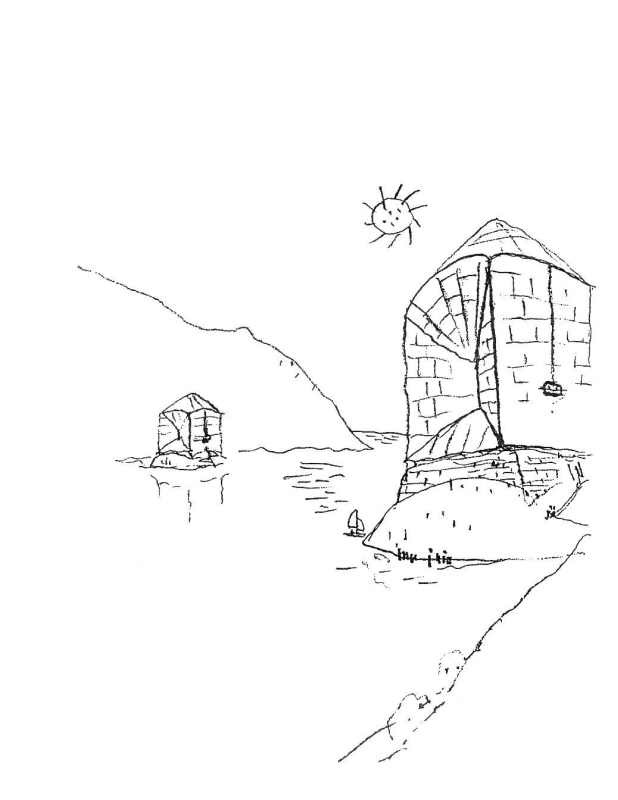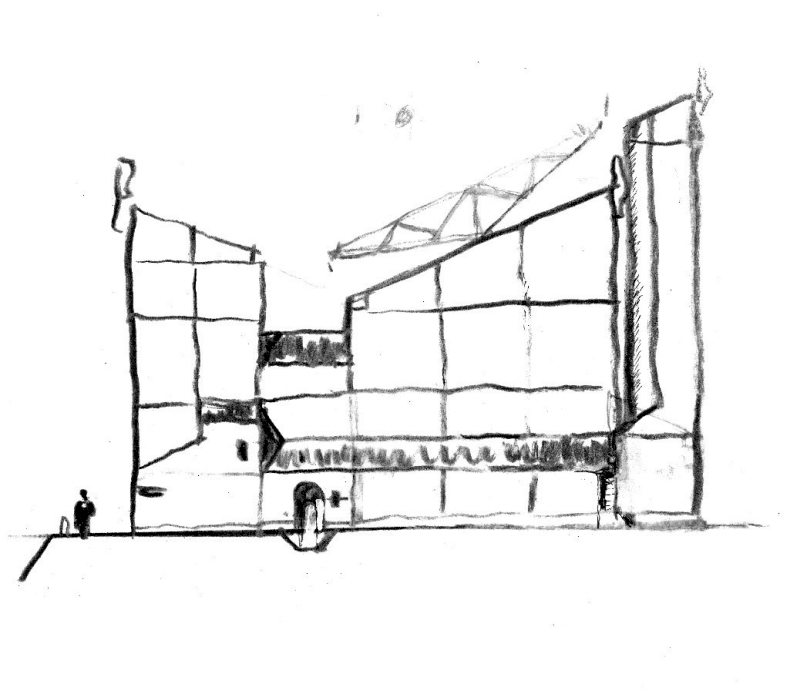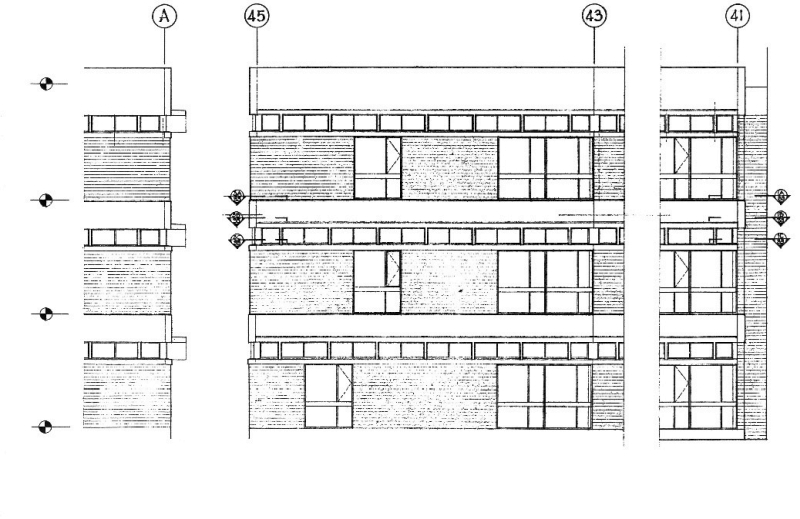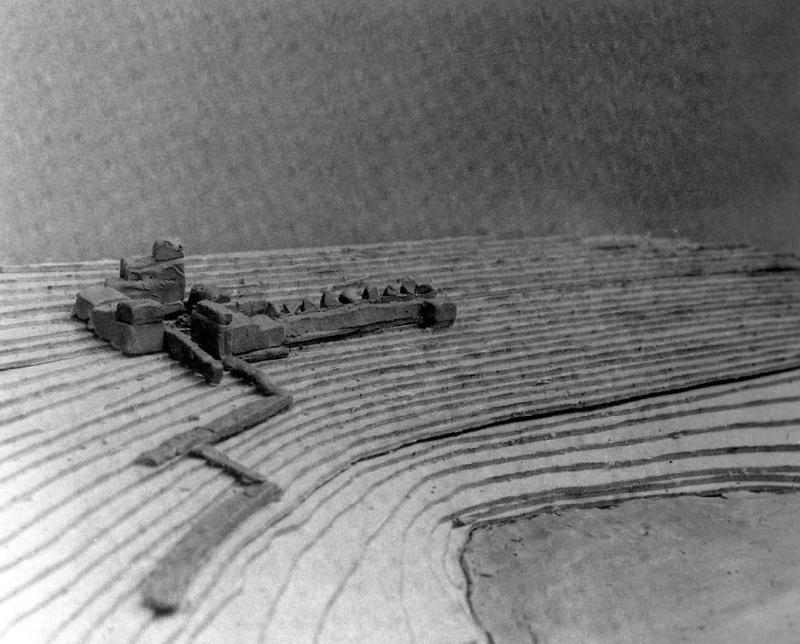From the “soft media” to the concept
legacy of Le Corbusier and his collaborators based on Jerzy
Sołtan’s designs and teaching
Szymon Mateusz
Ruszczewski
Fig.
1 - Jerzy Sołtan, pencil sketch of a monument for
‘Diomede’ competition for the end of the Cold War
(1989).


Fig.
2 - Jerzy Sołtan, pencil sketch of a church (1990s).
Fig.
3 - Jerzy Sołtan, charcoal-made elevations of the Salem High School
(1970-1976).


Fig.
4 - Jerzy Sołtan, technical elevation drawing of the Salem High School
(1970-1976).
Fig.
5 - Thomas Holtz, clay model of a ‘space of spiritual
retreat’ design for Jerzy Sołtan’s studio (1976).

«The initial creation moment of the project lies in
our soul and in our mind as a fluid thought, an element that cannot be
boxed at the beginning with sharper and rigid lines»
– these are words on Jerzy Sołtan’s approach
expressed by his design studio student from Harvard Graduate School of
Design (Guarracino 2020). Within the larger context of the importance
of hand drawn sketches for early design stage, this idea underlines the
relevance of “soft media” – such as
charcoal, soft crayons, and clay. Their relevance can be illustrated by
Sołtan’s teaching and by his own work, which had been
influenced by his employer in 1945-1949 and lifelong mentor, Le
Corbusier. Jerzy Sołtan (1913-2005) was a Polish modernist architect
who in addition to his own design work in Poland and in the United
States, was committed to teaching architecture at the Fine Arts Academy
in Warsaw and later at Harvard Graduate School of Design. His example
shows how Le Corbusier’s modus operandi
influenced his collaborators and how it could be passed onwards to new
generations of architects.
The article is based on extensive archival research of
designs, drawings, texts, and teaching-related documents illustrating
Sołtan’s body of work, in addition to a series of oral
history interviews with his students and colleagues from Poland and the
United States, contributing to understanding of the role of a specific
drawing technique in the creation of an architectural idea. After
explaining Le Corbusier’s approach to drawing during the
design process, the article concentrates on the role of these initial
visual explorations in Sołtan’s own architectural work and
practice. Further analysis on the application of these ideas in
Sołtan’s teaching at Harvard and of the impact it had on the
architecture students he taught enables to discuss the legacy of the
“soft media” approach.
Art, sketches, and Le Corbusier
Thanks to Sołtan, the account of Le Corbusier’s work
and routine has been very clear, as he explains in the essay
‘Working with Le Corbusier’ (1987), written first
in the 1980s and since published several times. He gives testimony of
how Le Corbusier was communicating, and of how design work proceeded.
He draws the image of Le Corbusier for whom architecture and painting
were tightly connected, but also an image of Le Corbusier who wanted to
use specific tools when working at the early stages on his designs. In
Sołtan’s account, the mornings were usually marked by Le
Corbusier’s absence who was working alone on art in his own
apartment. These paintings, artwork, and rough architectural sketches,
called by Sołtan «fine arts callisthenics», were
vital aspects to the development of Le Corbusier’s designs
(1995, p. 10). According to Sołtan, «it was for him a period
of concentration during which his imagination, catalysed by the
activity of painting, could probe most deeply into his subconscious. It
was probably then Le Corbusier produced his remarkably sensitive poetic
metaphors and associations» (1995, p. 11). In this sense,
Sołtan sees sketches and visual exploration as a vital element, not
only in Le Corbusier’s designs and projects, but also in his
theories and ideas. The importance of sketching and painting lies
exactly in the possibility of exploring what yet needs to be determined
and discovered. It means to work with rough ideas, which only later
would become clearer. It becomes evident in the account of Le
Corbusier’s sketching next to Sołtan, when the former was to
comment on mechanical pencils and more technical drawing tools saying,
«il ne faut pas immortaliser des aneries»
– one should not immortalise the
“assinine” (1995, pp. 21-22).
The “assinine” refers to the attempts,
trials, and uncertainties of the early stages of a design, when the
drawings should leave enough space for interpretation and should not
limit the further possibilities of development. To
«immortalise the assinine» would mean to yearn too
early for a definite line that prevents to alter the design. Indeed, Le
Corbusier’s sketches are called by Sołtan as «more
his digging into the subconscious, his guessing, than a finished
proposal» (1995, p. 18). It is also important to underline
that Le Corbusier wanted to apply these methods in the atelier too
– which could be easily understood from the imperative tone
he used when talking about drawing tools. Differently from many
functionalist designers, inclined to use more technical tools, Le
Corbusier wanted to follow his “pictorial thinking”
in the atelier (1995, p. 20). Therefore, Sołtan and other collaborators
were not only expected to decipher his drawings, but also to continue
to work in a similar spirit. As a result, Sołtan’s own design
workshop and artistic research stand as a manifestation of how this
approach could be shared by others.
From Le Corbusier to Sołtan’s workshop
Starting from the period of imprisonment in a POW camp in
Murnau during the Second World War, Sołtan had always had close
contacts with artists. In the camp, thanks to the high number of
intellectuals and artists amongst the prisoners, he became close with a
number of Polish painters, with whom he collaborated later in the 1950s
(Bulanda 1996). During this very same period, he started to paint much
more, probably using art as a cure for the harsh reality of
imprisonment (Sołtan 2019). That said, the importance of art and visual
research for Le Corbusier was aligned with Sołtan’s prior
experiences and interests, which resulted not only in a close
professional, but also intellectual relationship between mentor and
mentee. Both contacts with artists and Sołtan’s own painting
did develop during his stay in Paris: he was taking painting lessons
under Fernand Léger, and he entered the circle of artists
who were meeting at Le Corbusier’s apartment (Sołtan 1995, p.
51). Sołtan’s own writings from the 1950s indicate that he
was still researching new methods and forms in art, studying paintings
of various artists. In addition, a vast archive of his own artworks at
the Museum of the Fine Arts Academy in Warsaw testifies of a constant
research in visual arts, in parallel to his professional work as an
architect.
In addition, he was also often producing charcoal-made
sketches, similar to Le Corbusier’s. A number of those relate
to theoretical studies of churches (fig. 2), which he was working on
continuously throughout the years until the 1990s. Similar
charcoal-made drawings were produced for other designs, especially at
the conceptual stage for a number of designs in Poland and the United
States, such as ‘Warszawianka’ sporting centre in
Warsaw or Salem High School in Massachusetts. For example, in the
drawings from Salem, he used charcoal in order to visualise shadows,
materials, and to accentuate some aspects of the design (for example,
brickwork) without establishing precise patterns (fig. 3). As Sołtan
explained in his account from Le Corbusier’s studio, the lack
of precision of these drawings were enabling him to work on the project
gradually, being able to interpret some graphical signs left by
charcoal on paper in more ways than in case of thin and precise
pencil-made lines. In relation to this approach, one of
Sołtan’s collaborators in America, Edward Lyons, manager at
the office where Sołtan was the main designer, recalls, «he
would always do sketches on tissue with charcoal; he would not pick up
a pencil or a marker. He always wanted yellow too. You could not give
him a piece of white paper» (2019). These words relate
directly to the sketching practice that Sołtan inherited from Le
Corbusier – both charcoal and yellowish tissue or
butcher’s paper were often used in the atelier in Paris.
However, Sołtan’s approach was not limiting the use of
drawing utensils to those preferred by Le Corbusier during the whole
design process, but it was specific to the initial conceptual design,
as later stages of development of these same projects normally did
involve using more technical drawings (fig. 4).
Teaching Le Corbusier and “soft
media”
The influence of Le Corbusier was not although limited to
Sołtan’s own design workshop: he did refer to the same
approach and to the importance of visual research when he was teaching,
and many amongst his students from Harvard still remember it from the
design studios. Some claim that their interest in art and artistic work
were nourished by Sołtan’s influence at the school (Holtz
2019). Indeed, he was much interested in his students’
artistic production – as is shown in his letter to his former
student at Harvard, Michael Graves, where he states, «I
personally want to compliment you particularly warmly in relation to
your paintings» (1974). His contact and correspondence with
former student and artist Jacek Damięcki on his work equally point to
the importance of visual research for the development of an
architect’s mind according to him (2019). These contacts
suggest therefore the existence of a thread of continuity of artistic
method, coming from Le Corbusier, channelled through Sołtan and his
teaching, and then passed on to the latter’s students.
In general, these exchanges illustrate how much
Sołtan’s vision of architecture was drawings-driven and it
implies how much the design process relied on drawing, painting, and
graphical exploration. In his design studios at Harvard, specific
drawings would become key features to students’ projects.
While some students remember working with plans, for others the focus
was put on sections: the choice of drawings could have been then
tailored to the specific needs of a given design or a given student
(Davis 2021, Lombard 2020, Wattenberg 2020). However, regardless of the
focus on a specific type of drawings, artistic expression was more
important. Visual research was in fact helpful in defining the parti
(a small drawing, which in the 1970s was a common reference in the
design process at Harvard) and in defining the main concept idea coming
from different layers of single problems. In addition, in theoretical
modules at Harvard, Sołtan was both illustrating to the students Le
Corbusier’s daily routine and underlining the importance of
painting for Corbusian architecture, reinforcing thus his suggestions
for more artistically skilled students. «I want them really
to know, to be able (if they wish) to apply [Le Corbusier’s
design method]», he mentioned in a note from his theoretical
seminar.
Along with illustrating the importance of the visual research
in the design process, Sołtan tried to propose the students to use
similar drawing techniques while designing. The suggestion to use
“soft media” – soft pencils, charcoal,
clay – completed Sołtan’s contribution to extending
Le Corbusier’s influence on his students. They were aimed to
facilitate exploration of ideas and leaving the possibility for the
imagination to complete a more generic drawing. The words
«don’t be so painfully precise», as he
told one of his students, illustrate well this approach (Holtz 2019).
According to Sołtan, only afterwards, after having worked with those
more malleable techniques, more practical questions related to
functionality, technology, and construction appeared, and more detailed
drawings were of use. His former student and architect Karl Fender
recalls his words from the first studio day (2020):
I want you all […] to buy clay, I want you to buy
charcoal, and I want you to buy butcher’s paper
[…]. We are going to explore ideas through these mediums,
because you are going to get filthy hands, and you are going to have
filthy drawings and rough lumps of clay to explore your thinking
– and this will focus you on the essence.....you will be
confronting the essence of the search for a truthful architecture. With
these tools, you will not fall in love with your handicraft. You will
have models that honestly and basically test your options and your
explorations.
Through getting hands dirty, through drawing these undefined
lines, there was more space left for exploring the essentials, the
basics of architecture. In some assignments, he suggested the students
to submit freehand drawings, and some students recall that their
tendency to draw in a less precise manner, using charcoal or very soft
crayons (fig. 5), was due to Sołtan’s influence (Holtz 2019).
As in his accounts from Paris, imprecise drawing during the first phase
of design was a tool to find the ideas and to understand the poetics
underlying the design. It was to detach the students from drawing
beautifully something that was not enough cross-examined, making a
direct connection between the design work, the concept (the parti),
and critical thinking and questioning – referred by some as a
constant element of Sołtan’s reviews and discussions (Wesley
2006). Another student and architect Christopher Benninger explains
this adding (2021), «his technique was to ask the student a
question that needed analysis to answer, and often it would be that
there was no possible answer. That silence was the
conclusion». Along with the drawings, constant questioning
was then another tool, which helped the students to work at the core of
their design decisions and push their ideas further.
Legacy: between Sołtan and Le Corbusier
Sołtan’s teaching was widely recognised by his
students. «I have won the lottery», commented David
Parsons referring to him having Sołtan as thesis advisor (2016, p. 54).
Amongst direct testimonies from his students, a number of them refer to
passion, help, and intensity in teaching, and only a couple remember
him as less sympathetic. In 2002, twenty-three years after his
retirement from the professorship at Harvard, Sołtan was awarded with
the Topaz Medallion, the highest recognition the American Institute of
Architects and the Association Collegiate of Architecture Schools can
give to an architecture educator. Although the award came years after
he was teaching at Harvard, the backing was impressive, including
support letters from Charles Gwathmey and Michael Graves, from Kenneth
Frampton, and from architecture professors and deans from Harvard, MIT,
and Berkeley. They all pointed to his contribution to architectural
education by teaching modernism: «Jerzy Sołtan has brought to
Harvard, and to other schools and forums, a sense that Le Corbusier,
his own mentor and friend, has been alive for an extra
generation» (Chermayeff 1989). It would have not been
possible to keep Le Corbusier alive without the importance of visual
art, without charcoal, and without getting hands dirty. As to whether
his approach is still of value, one can refer again to
Sołtan’s former students, who admit to use their experience
of being taught by him when teaching and designing themselves, even
nowadays.
References
BENNINGER C. (2021) – Interview by Szymon
Ruszczewski from 29/11/2020 and 20/01/2021, see: RUSZCZEWSKI S. (2022)
– Finding Sołtan: legacies and heritages of
modernist architecture. PhD thesis, School of Architecture,
University of Sheffield.
CHERMAYEFF P. (1989) – Letter to AIA Awards
Department from
04/01/1989. Jerzy Sołtan Nomination, AIA Archives, Washington DC.
DAMIĘCKI J. (2019) – Interview by Szymon Ruszczewski
from 28/09/2019, see: RUSZCZEWSKI S. (2022) – Finding
Sołtan: legacies and heritages of modernist architecture.
PhD thesis, School of Architecture, University of Sheffield.
DAVIS M. K. (2021) – Interview by Szymon Ruszczewski
from
15/01/2021, 02/02/2021 and 13/04/2021, see: RUSZCZEWSKI S. (2022)
– Finding Sołtan: legacies and heritages of
modernist architecture. PhD thesis, School of Architecture,
University of Sheffield.
FENDER K. (2020) – Interview by Szymon Ruszczewski
from 19/10/2020, see: RUSZCZEWSKI S. (2022) – Finding
Sołtan: legacies and heritages of modernist architecture.
PhD thesis, School of Architecture, University of Sheffield.
GUARRACINO U. (2020) – Interview by Szymon
Ruszczewski from 11/05/2020, see: RUSZCZEWSKI S. (2022) – Finding
Sołtan: legacies and heritages of modernist architecture.
PhD thesis, School of Architecture, University of Sheffield.
HOLTZ T. (2019) – Interview by Szymon Ruszczewski
from 11/04/2019, see: RUSZCZEWSKI S. (2022) – Finding
Sołtan: legacies and heritages of modernist architecture.
PhD thesis, School of Architecture, University of Sheffield.
LYONS E. (2019) – Interview by Szymon Ruszczewski
from 02/04/2019, see: RUSZCZEWSKI S. (2022) – Finding
Sołtan: legacies and heritages of modernist architecture.
PhD thesis, School of Architecture, University of Sheffield.
PARSONS D. (2016) – Architecture
Education at Harvard Then (1965) and Now (2015). Create
Space.
SOŁTAN Jerzy (1951) – Diary notes from 11/11/1951.
Jerzy Sołtan Collection, Museum of the Fine Arts Academy, Warsaw.
SOŁTAN Jerzy (1974) – Letter to Michael Graves from
06/12/1974. Jerzy Sołtan Collection, Museum of the Fine Arts Academy,
Warsaw.
SOŁTAN Jerzy (1987) – “Working with Le
Corbusier”. In: H. Allen Brooks (ed. by), Le
Corbusier: the Garland essays. Garland, New York.
SOŁTAN Jerzy (1995) – Draft of a book On
Architecture and Le Corbusier from November 1995. Jerzy
Sołtan Collection, Museum of the Fine Arts Academy, Warsaw.
SOŁTAN Joanna (2019) – Interview by Szymon
Ruszczewski from 28/03/2019.
WATTENBERG A. (2020) – Interview by Szymon
Ruszczewski from 24/04/2020, see: RUSZCZEWSKI S. (2022) – Finding
Sołtan: legacies and heritages of modernist architecture.
PhD thesis, School of Architecture, University of Sheffield.
WESLEY R. (2006) – Lecture “All Men Are
Born Fools: a
Tribute to Jerzy Sołtan, 1913-2005” from 03/03/2006. Richard
Wesley private archive.




